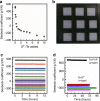In-situ resonant band engineering of solution-processed semiconductors generates high performance n-type thermoelectric nano-inks
- PMID: 32350274
- PMCID: PMC7190739
- DOI: 10.1038/s41467-020-15933-2
In-situ resonant band engineering of solution-processed semiconductors generates high performance n-type thermoelectric nano-inks
Abstract
Thermoelectric devices possess enormous potential to reshape the global energy landscape by converting waste heat into electricity, yet their commercial implementation has been limited by their high cost to output power ratio. No single "champion" thermoelectric material exists due to a broad range of material-dependent thermal and electrical property optimization challenges. While the advent of nanostructuring provided a general design paradigm for reducing material thermal conductivities, there exists no analogous strategy for homogeneous, precise doping of materials. Here, we demonstrate a nanoscale interface-engineering approach that harnesses the large chemically accessible surface areas of nanomaterials to yield massive, finely-controlled, and stable changes in the Seebeck coefficient, switching a poor nonconventional p-type thermoelectric material, tellurium, into a robust n-type material exhibiting stable properties over months of testing. These remodeled, n-type nanowires display extremely high power factors (~500 µW m-1K-2) that are orders of magnitude higher than their bulk p-type counterparts.
Conflict of interest statement
A.S., B.R., M.L., F.Y., J.D.F., N.E.C., R.A.S., and J.J.U. are listed as inventors on a patent filed by the University of California, Berkeley in September 2016, entitled “Surface Doping of Nanostructures” for the surface doping procedure described in Fig. 1.
Figures







References
-
- Yau, C.-W., Kwok, T. T.-O., Lei, C.-U., Kwok, Y.-K. Energy harvesting in internet of things. in Internet of Everything: Algorithms, Methodologies, Technologies and Perspectives (eds Di Martino, B., Li, K.-C., Yang, L. T. & Esposito, A.) (Springer, Singapore, 2018).
-
- Bahk J-H, Fang H, Yazawa K, Shakouri A. Flexible thermoelectric materials and device optimization for wearable energy harvesting. J. Mater. Chem. C. 2015;3:10362–10374. doi: 10.1039/C5TC01644D. - DOI

